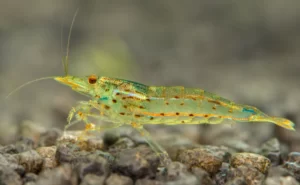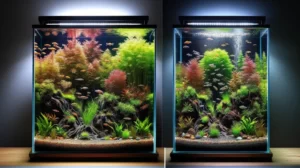
6 Reasons Why Your Red Root Floaters Are Dying

Writer at The Aquarium Keeper
Every fishkeeper loves some red color in their fish tanks. Red root floaters are one of the easier plants to keep, and their appearance is absolutely stunning.
Nevertheless, some people struggle to keep these plants, as sometimes they can die off due to various reasons. This article will cover those reasons, as well as provide solutions, so you could have lots of red root floaters in your tank.
Reasons Why Red Root Floaters Are Dying
The most common cause of red root floaters dying is improper lightning and nutrient deficiency. These plants don’t like lightning, that is too weak. Also, not enough nutrients in the water can be another reason, why red root floaters keep dying in your aquarium.

there are many other factors, that can be troubling to this plant, including competition, water parameters, water flow, and chemicals. As you can see, there can be a lot of reasons why aquarium plants are dying, and it is important to pinpoint which causes are present in your tank.
Inproper Water Parameters
Firstly, improper water parameters often can be a leading cause, of why plants die off, including red root floaters. The most common parameters are water temperature, and pH, which are often different and need to be adjusted according to the plant. Also, a large build-up of ammonia or nitrates can also hurt your red root floaters.
| Aspect | Information |
|---|---|
| Scientific Name | Phyllanthus fluitans |
| Origin | Amazon Basin in South America |
| Water Temperature | 18–30 °C (64-86 °F) |
| Growth Rate | Moderate to Fast |
| Light Intensity | Medium to High |
| pH | 6.0 - 7.5 |
| Need for CO2 | Not necessary, but can benefit growth |
| Maximum Size | 1-3 inches (floating leaf diameter) |
| Care Level | Easy to Moderate |
Solution: Regularly check your water parameters, including water temperature, pH, ammonia, and nitrate levels. Be sure there are no ammonia or other toxins present in the aquarium since they are harmful to plants and fish. Also, keep the temperature and pH in the optimal range, and make sure there are no large sudden fluctuations in these water parameters.
Bad Lightning Conditions
Another common reason why red root floaters keep dying is improper lighting conditions. These plant species really need moderate to intense light, and would probably be not the best option for low-light or low-tech aquariums. Also, the stronger and better your lightning is, the more red these plants turn.

Solution: If you have good water parameters, and your water contains enough nutrients, and if still the plants are dying off and not turning red, it can be because of the light. If that happens, simply try to purchase a stronger light for your aquarium.
Nutrient Deficiency
Moving on, nutrient deficiency is another leading cause, of why red root floaters can start melting and dying. These plant species, just like any other plant, need nutrients to thrive and multiply. If you don’t have a nutrient-rich substrate (that often releases nutrients into the water), or liquid fertilizer, nutrient deficiency might be the reason why your red root floaters are dying.
Solution: The most straightforward solution is to simply start using liquid fertilizer for your aquarium plants. There are many options out there, but just be sure to follow the instructions for the fertilizer, as too much nutrients can lead to increased algae or even algae blooms.
Strong Water Flow
Water flow is necessary in an aquarium, it helps aerate the tank, and at the same time prevents disgusting biofilm from forming at the top of your aquarium. However, too much water flow can be bad for floating plants, especially red root floaters. Too much disturbance can simply stress the plant, preventing it from properly absorbing nutrients and multiplying.
Solution: Strong water flow is usually caused by the aquarium filter. Maybe you have a top fin filter, or a sponge filter, or any other kind, and most of them can have a strong flow. The simple solution in this case is to just adjust the water flow to be weaker, you can do that by configuring your filter or using a sponge, or decorations, or even going DYI and building something, that can be attached to the filter for flow reduction.
Chemical Exposure
Chemical exposure is a less common cause of red root floaters dying in an aquarium, but it still might be a reason. Copper is a common example, often found in certain fish medications and algaecides. Other heavy metals like lead, mercury, and zinc can also be harmful if present in significant quantities.
Solution: For this problem, the fix is fairly simple. Always read the labels of aquatic medication, and fertilizers before adding them to the tank, make sure they are plant-friendly. Also, if you found yourself in this situation, doing a big water change would usually minimize the damage done to the plants, since fresh newly added water would be chemical-free.
Too Much Competition
The last cause on this list is too much competition. What I mean by that, is if you have lots of different floater plants in your fish tank, some of them (duckweed, salvinia) may be better at absorbing nutrients in the water and growing faster. This can lead to less and less nutrients and space for your red root floaters, and it can slowly kill them.

Solution: I would highly suggest limiting the amount of different floating plant species you keep in your fish tank, or at least don’t let the floater plants take over the whole surface of the tank. This would ensure, that all of them would have enough space to grow. I would also suggest not keeping plants like duckweed or salvinia, since both of these are extremely fast growers, and can suck up nutrients quickly.
Frequently Asked Questions
Why Are My Red Root Floaters Melting?
If you just purchased your red root floaters and added them to the tank, it is normal, that some of them will melt, since they are adjusting to a different environment. If that is not the case, there might something be wrong with your water parameters, or there might be not enough nutrients.
How Fast Do Red Root Floaters Grow?
Red root floaters grow relatively fast, compared to other aquatic plants. In terms of floating plants, these species grow slower, compared to more popular plants like duckweed or salvinia.
Writer's Thoughts
Red root floaters are amazing, and look absolutely stunning in every fish tank. I really love these species, since they can add an extra coloration to the aquarium, compared to the traditional green plants.

Thank you for reading my blog post. This website was created with the sole intention of providing quality information regarding fishkeeping. I have been in the fishkeeping hobby for 8 years, and through many trials and errors as well as online research I gathered a lot of information, which I want to give back to the community.




How to Choose the Best Substrate for Aquarium? Aquasoil, Sand & More


